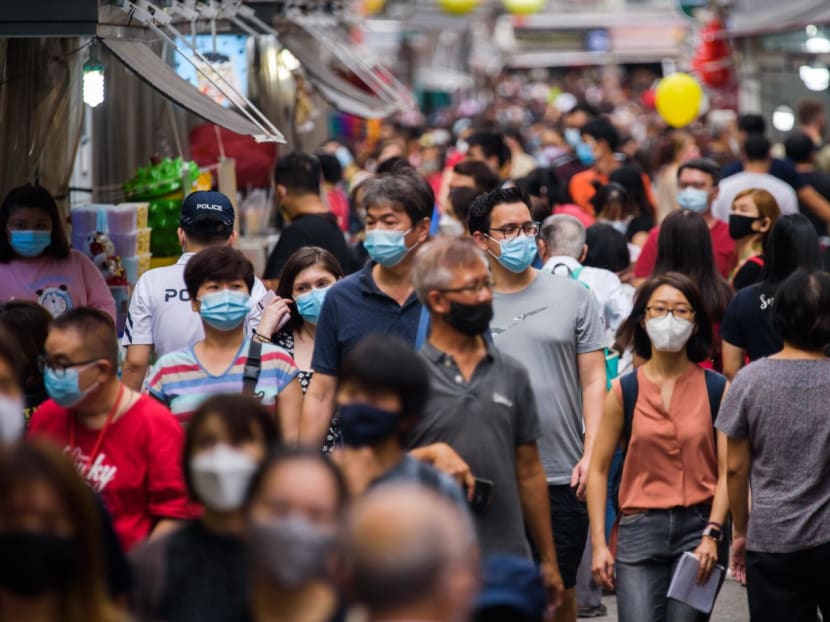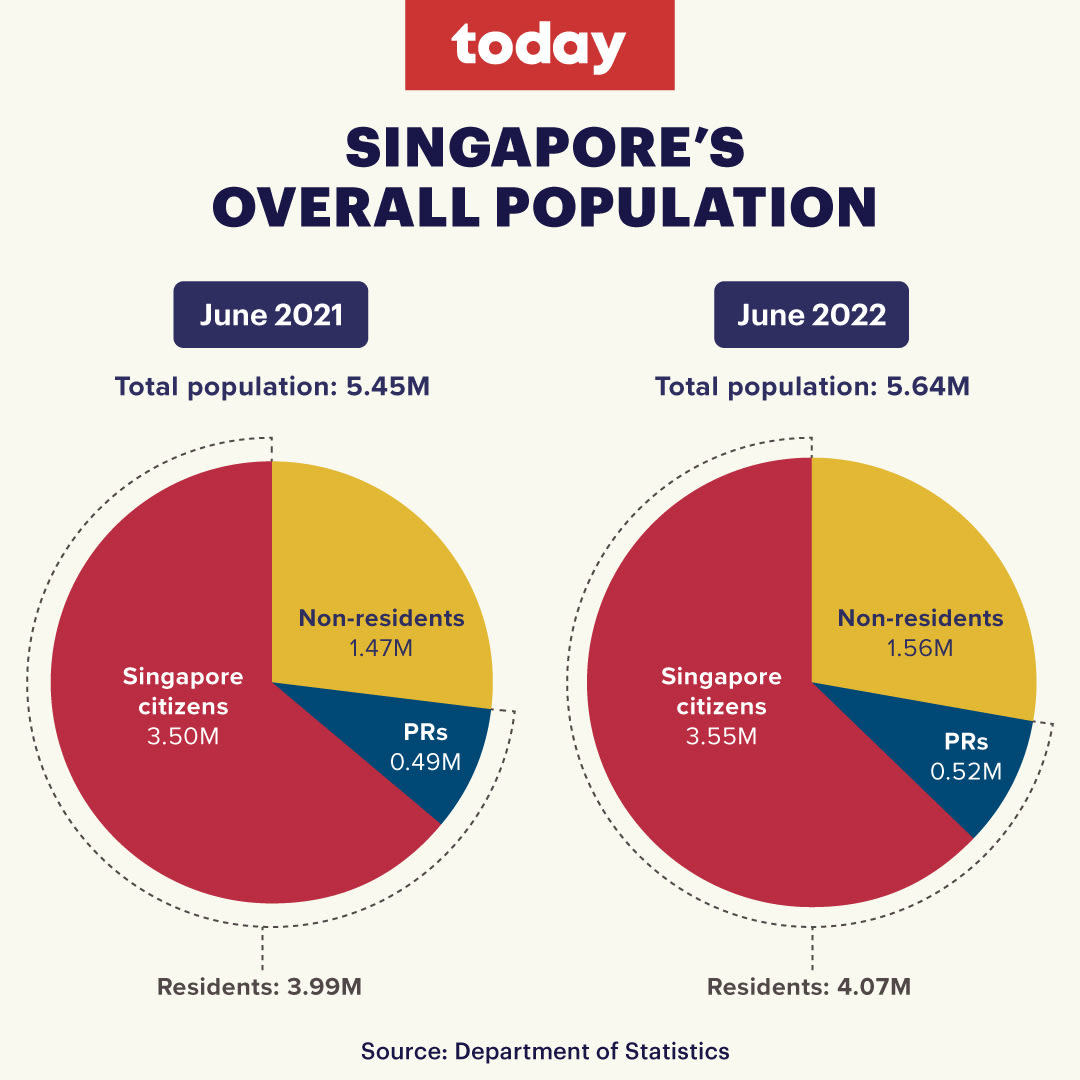Singapore's total population up 3.4% year-on-year to 5.64 million in June 2022, but still below pre-pandemic levels
SINGAPORE — After two years of decline due to border restrictions from the Covid-19 pandemic, Singapore’s total population grew by 3.4 per cent to 5.64 million in June 2022 from a year earlier.

- Singapore's overall population jumped by 3.4 per cent year-on-year as of June 2022
- The citizen, permanent resident and non-resident populations all saw increases
- The increase in the citizen and permanent resident populations largely reflected the easing of Covid-19 travel restrictions, allowing those living overseas to return to Singapore
- The non-resident population rose 6.6 per cent, with most of the increase coming from work permit holders in the construction, marine shipyard and processes sectors
SINGAPORE — After two years of decline due to border restrictions from the Covid-19 pandemic, Singapore’s total population grew by 3.4 per cent to 5.64 million in June 2022 from a year earlier.
However, this is slightly below the pre-Covid level of 5.7 million in June 2019.
This increase was spurred by the easing of Covid-19 travel restrictions, as more citizens and permanent residents (PRs) who had been living overseas returned to Singapore.
These statistics were among the latest data from the Government’s annual Population in Brief report that was released on Tuesday (Sept 27).
The non-resident population rose by 6.6 per cent in this same period to 1.56 million, contributing to the overall population’s increase. However, the non-resident population was also still lower than the pre-Covid level of 1.68 million in June 2019.
This was mostly a result of the easing of Covid-19 travel restrictions, and the largest increase of non-resident population was for work permit holders in the construction, marine shipyard and process sectors.
In 2021, 33,435 individuals were granted PR status — the highest figure since 2009 when Singapore tightened its immigration framework.
The following is a breakdown of the data.
OVERALL POPULATION
- Singapore’s total population stood at 5.64 million as of June 2022
- There were 3.55 million Singapore citizens, an increase of 1.6 per cent from 3.5 million in June 2021
- There were about 520,000 PRs, an increase of 6.3 per cent from 490,000 in June 2021
- The non-resident population, comprising the foreign workforce across all pass types, dependants and international students, totalled 1.56 million. This was an increase of 6.6 per cent compared to June 2021

JUMP IN FOREIGN EMPLOYMENT GROWTH
- Singapore saw a growth in foreign employment after two years of decline
- From June 2021 to June 2022, foreign employment growth was about 98,000
- In comparison, foreign employment fell by about 147,000 from June 2020 to June 2021
AGEING POPULATION
- The proportion of citizens age 65 and above rose sharply from 11.1 per cent in 2012 to 18.4 per cent in 2022
- The median age of the citizen population rose from 42.5 years to 42.8 years between June 2021 and June 2022
- In the decade since 2012, the number of citizens aged 80 and older has surged by more than 70 per cent from 75,000 to 132,000

MORE MARRIAGES, WITH OLDER GROOMS AND BRIDES
- Citizen marriages are up 20.6 per cent, with 23,433 marriages in 2021 as compared to 19,430 marriages in 2020
- This is due to the easing of Covid-19 infection control measures on weddings
- Grooms and brides are also getting married later — the median age at first marriage was 30.3 years for men and 28.7 years for women respectively in 2021, up from 30.1 and 27.8 years respectively in 2011
FEWER BIRTHS
- There were 31,713 citizen births in 2021, slightly fewer than the 31,816 births in 2020
- In the past five years, there were about 32,200 citizen births on average
- This is lower than the average of about 32,900 in the preceding five years from 2012 to 2016
- The fall is attributed to the delays in marriage and childbearing plans because of uncertainties brought about by Covid-19
- The median age of citizen mothers giving birth to their first child also increased, at 31 years in 2021 compared to 29.8 years in 2011
- The resident total fertility rate was 1.12 in 2021, up from the low of 1.1 in 2020. However, it is still well below the replacement rate of 2.1
IMMIGRATION AND CITIZENS
- In 2021, 21,537 citizenship applications and 33,435 PR applications were granted
- This was higher than the 21,085 citizenship and 27,470 PR applications granted in 2020
- The processes to grant citizenship or PR status — which have to be completed in person — were slowed down in 2020 due to travel restrictions and infection controls related to Covid-19
- Notably, the PR applications granted in 2021 were at the highest level since 2009, the year the immigration framework was tightened

WHY IT MATTERS
Commenting on the latest statistics, Professor Paulin Straughan, a sociologist from Singapore Management University, said she was glad to see that population numbers have nearly returned to pre-pandemic levels.
However, with Singapore’s greying population, there are some actions that the Government can take, she suggested.
For one, there should be increased efforts to make Singapore a family-friendly society, so that young adults do not need to choose between parenthood and their careers.
“We need to ensure that they don't see forming families as an opportunity cost… Family policies in Singapore are already generous, we need to continue on that trajectory.”
For example, companies should continue being flexible with work arrangements, allowing their employees to work from home.
“The Covid-19 period has proven that people aren’t necessarily less productive if they work from home or have flexible work hours,” she added.
She also said that Singapore needs to better engage its population above 65 and not see them as liabilities in the workforce.
“This large group of baby boomers that are entering the above-65 age group means that we need to ensure we engage them… They have lived through different eras, have rich experiences, are well-educated and have so much they can contribute,” Prof Straughan stressed.
Although Singapore has already increased the retirement age, she said that more should be done to help this age group find meaningful ways to support themselves.
“Quality of life comes with health, and health-adjusted life expectancy looks at health more. We have to minimise this gap so that our elders may live a good life, not just a long one.Professor Paulin Straughan on the need to take a closer look at health-adjusted life expectancy”
What Prof Straughan hopes to see in future population statistics is the “health-adjusted life expectancy”. This means the life expectancy takes into account the quality of one’s life spent in different states of health.
She explained: “While we are living longer, we aren’t leveraging every year of our lives.”
On its website, the latest figures the Ministry of Health published for health-adjusted life expectancy was in 2019. It was 73.7 for males and 75.2 for females.
However, in 2019, life expectancy at birth was 81.4 for males and 85.9 for females.
"Health-adjusted life expectancy is the number of years someone lives without disabilities, and it's almost a 10-year gap, which is a very long time for poor quality of life," Prof Straughan said, adding that chronic illnesses or mobility issues could impair quality of life.
"Quality of life comes with health, and health-adjusted life expectancy looks at health more. We have to minimise this gap so that our elders may live a good life, not just a long one."
Even though the Government already announced plans to reform the healthcare system here through Healthier SG, Prof Straughan said that the population statistics are a reminder that more needs to be done for those above 65 years old to age healthier and well.
Alongside the need to engage the ageing population and encourage younger Singaporeans to have children, she noted that attracting foreign workers is crucial for the country’s growth.
“Looking at the proportion of Singapore citizens and PRs, you’ll notice that they are very carefully calibrated. But we can be dynamic with the non-resident population, (whose numbers) have dropped during the Covid-19 pandemic,” she said.
Adding that such talent would help build the economy — before possibly calling Singapore their home and building a family here — she said it is also crucial that Singapore continues being an open society and an attractive destination for global talent.











